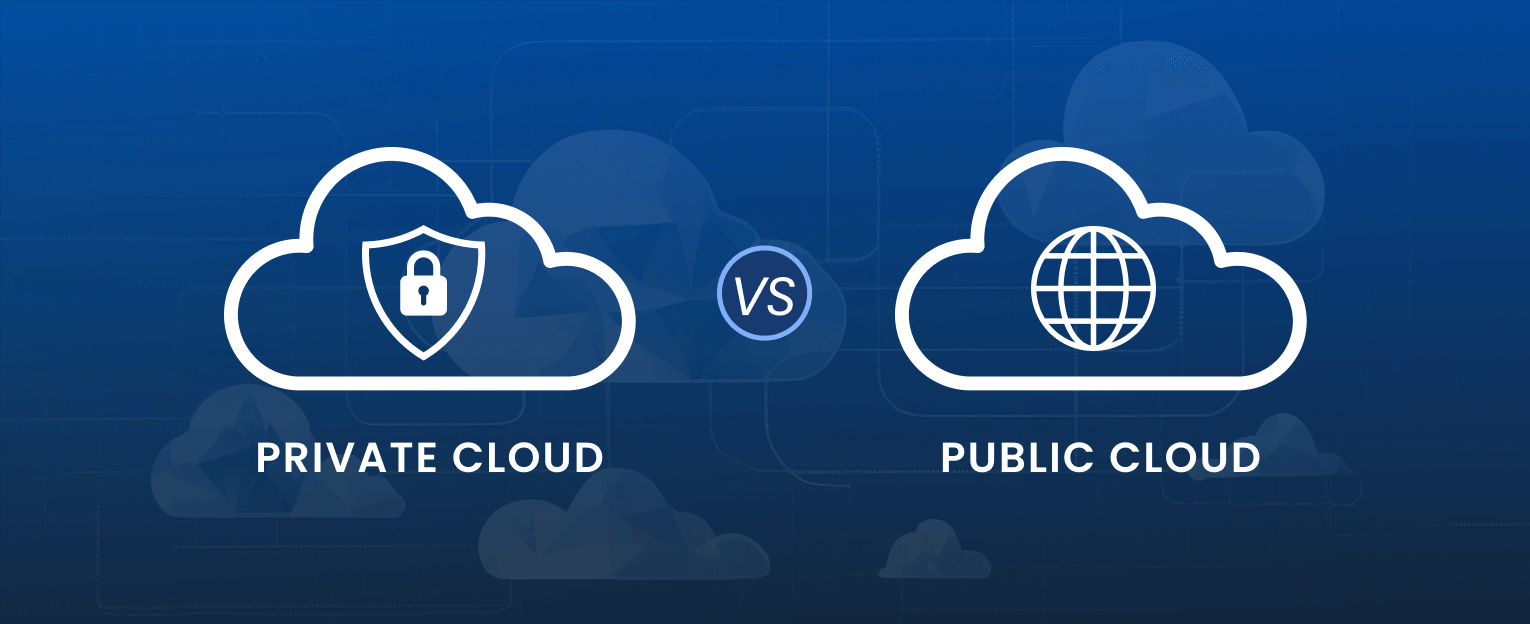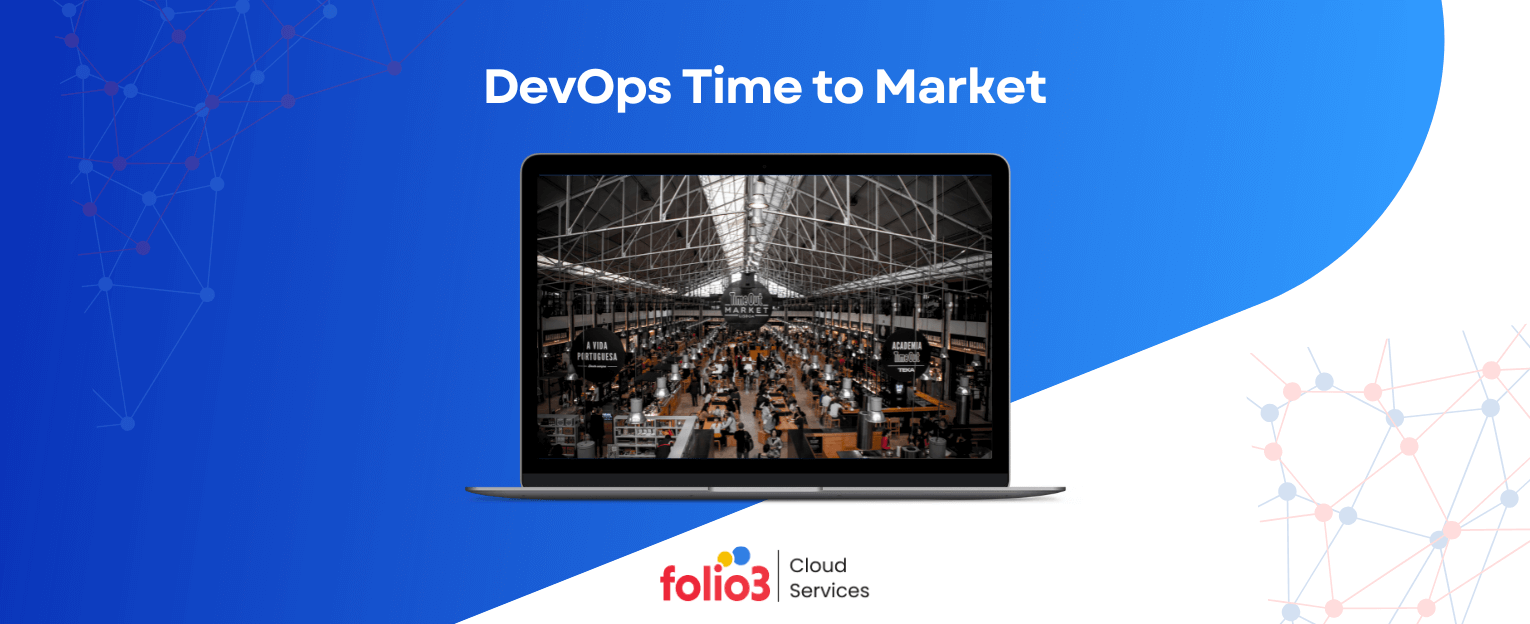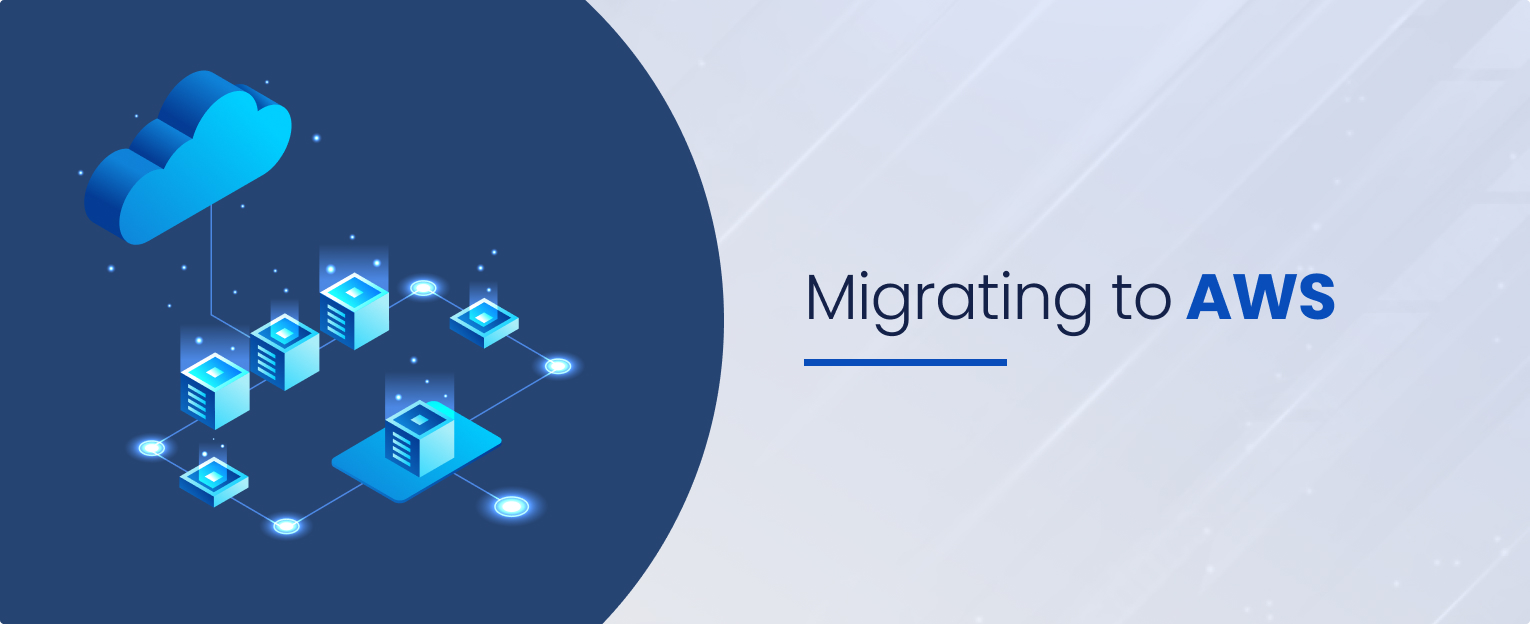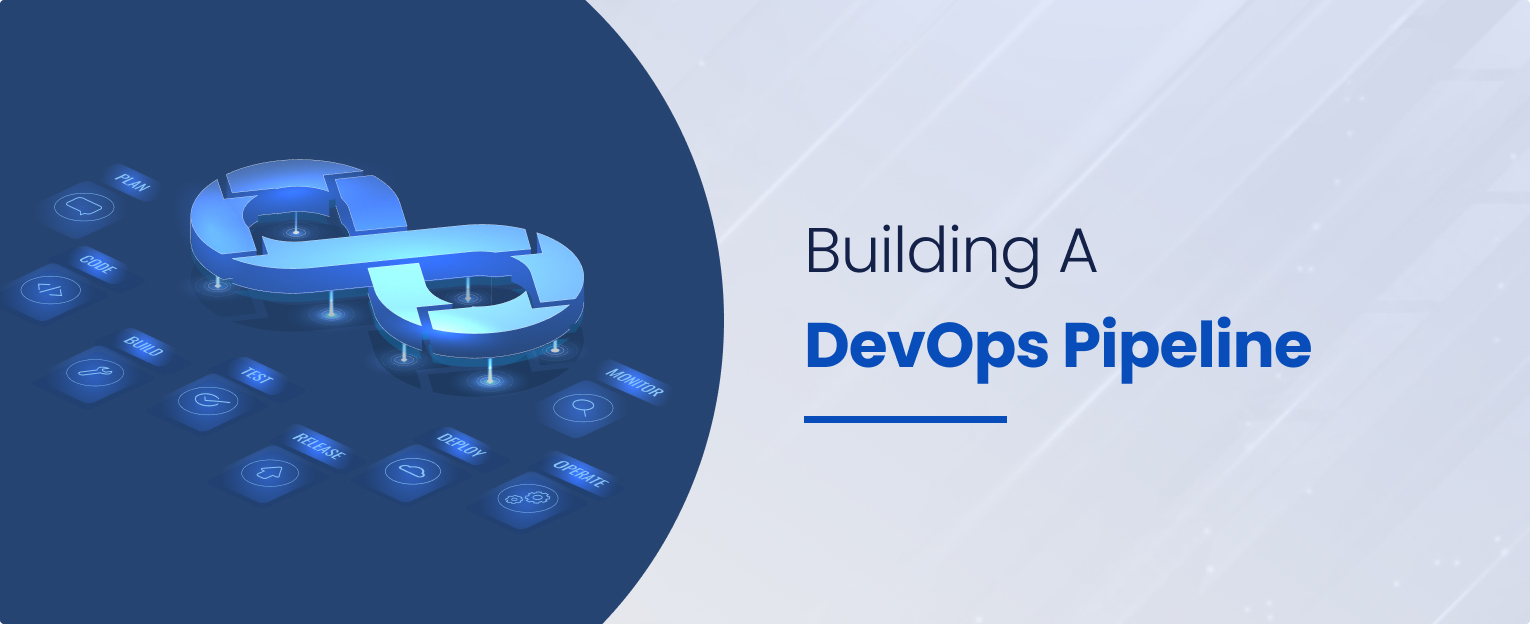Cloud computing brings us to a critical fork: private and public clouds. Understanding the distinctions between these two approaches is paramount in shaping an organization’s IT strategy.
In this blog, we will explore the differences between Private and Public Clouds, including their fundamental differences, and guide you toward informed decision-making in the dynamic industry of cloud technologies.
Private Cloud vs Public Cloud: Difference Explained
Private and public clouds provide on-demand IT resources over a network. In a private cloud, a single organization manages the infrastructure for resource delivery. Conversely, a public cloud offers fully managed services by external providers.
Imagine an organization with departments like finance and marketing requiring computing resources. The organization controls central hardware in a private cloud, distributing resources over a network. In a public cloud, teams access fully managed services from external providers, maintaining control over resource choices.
What is a Public Cloud?
A Public Cloud refers to computing services provided by external vendors over the public Internet. Accessible to all, these services can be free or purchased on-demand, enabling users to pay solely for the resources they consume, such as CPU cycles, storage, or bandwidth. This decentralized approach offers flexibility and scalability, making it an attractive option for diverse users.
Public clouds, hosted by providers like AWS, Azure, or Google Cloud, relieve infrastructure management duties. In Infrastructure-as-a-Service (IaaS) public cloud setups, data and code dwell on shared servers, serving various organizations.
Public clouds excel in backup, business continuity, reducing web app latency, and dynamic resource scaling (‘cloud bursting’). Despite robust physical security in hyper-scale providers, a shared responsibility model demands organizations secure their apps and networks, monitor for malware, and encrypt data at rest and in motion.
What is a Private Cloud?
Like a data center, a Private Cloud operates on a company’s infrastructure with robust firewall protection and physical security. Established organizations often transform existing investments into a private cloud, yielding significant financial advantages.
While ownership brings control, the responsibility for security—from physical measures to encryption and cybersecurity—rests solely with the organization. Private clouds eliminate multitenancy concerns, ensuring dedicated infrastructure and minimal latency for local applications and users.
Similarities Between Private and Public Clouds
In the evolution of cloud services, Amazon took the lead by introducing Amazon Web Services (AWS), initially focusing on delivering computing and storage infrastructure. Subsequently, many large organizations sought to replicate the cloud computing model within their internal infrastructure.
In the evolution of cloud services, Amazon took the lead by introducing Amazon Web Services (AWS), initially focusing on delivering computing and storage infrastructure. Subsequently, many large organizations sought to replicate the cloud computing model within their internal infrastructure.
1. Infrastructure on Demand:
Both cloud types abstract and share computing resources like hardware, networks, software, servers, and storage over a network.
Users can allocate, release, and manage resources as needed, avoiding scarcity or underutilization.
2. Similar Underlying Technologies:
Virtualization is a foundational technology for abstracting underlying hardware and delivering it through APIs.
Both models share features like automatic scaling, orchestrated automation, fault resiliency, and improved backup systems.
3. Operational Efficiency:
Both private cloud vs public cloud enhance operational efficiency in IT infrastructure.
Centralized infrastructure management leads to cost savings, increased scaling speed, faster time to market, improved utilization, and lower overall costs.
4. Virtualization Technology:
The foundational virtualization technology is a common thread between private and public clouds—both leverage virtualization to optimize resource utilization, enabling the efficient allocation and management of computing resources.
5. Self-Service Capabilities:
Both private and public clouds provide self-service capabilities, allowing users to provision and manage resources autonomously. This empowers organizations to streamline processes, reduce administrative overhead, and enhance operational efficiency.
6. Automation and Orchestration:
Automation and orchestration are crucial elements in both private and public cloud environments. Organizations can achieve operational efficiency and consistency in resource provisioning and management by automating repetitive tasks and orchestrating complex workflows.
7. Network Connectivity:
Both deployment models rely on robust network connectivity. Whether within the confines of a private data center or across geographically dispersed public cloud servers, a reliable network infrastructure is essential for seamless data access and communication.
8. Resource Pooling:
Resource pooling is a shared characteristic in which computing resources are pooled and allocated based on demand. This allows for efficient resource utilization and ensures that resources are dynamically allocated to meet changing workload requirements.
Despite these parallels, achieving a private cloud with features comparable to the public cloud remains challenging for many organizations. While both models bring operational efficiency, the public cloud often proves more robust across various use cases.
9. Cost Efficiency:
Both private and public clouds contribute to cost efficiency. While private clouds can optimize existing infrastructure investments, public clouds offer a pay-as-you-go model, allowing organizations to pay for the resources they consume, thereby avoiding unnecessary upfront costs.
10. Scalability
Both private and public clouds offer scalability, allowing organizations to adjust their computing resources according to demand. Whether handling increased workloads or scaling down during periods of reduced activity, both deployment models provide the flexibility to adapt resources dynamically.

Security and Compliance
Prioritize data security and compliance needs. If dealing with sensitive data or strict regulations, consider the dedicated resources of a private cloud.
Key Differences: Public Cloud Vs Private Cloud
Public vs public clouds differ in how IT resources are delivered over a network. In a private cloud, a single organization manages its infrastructure, providing resources internally.
In contrast, public clouds, operated by external providers, offer fully managed services. Applications necessitate computing resources such as memory, storage, and CPU.
Consider an organization with departments like finance and marketing requiring computing resources. The organization owns and maintains server hardware centrally in a private cloud, distributing resources internally.
In a public cloud, teams access fully managed services from external providers, maintaining control over resource choices.
Replicating public cloud infrastructure privately is nearly impossible. Public cloud providers offer a broader and deeper range of services, driven by their dedication to scaling and innovation.
Access to a global community and proven operational expertise further distinguishes public clouds.
Infrastructure
Public cloud providers offer scalable infrastructure globally, catering to diverse geographies and computing needs. Replicating this scale and quality privately proves challenging, as private organizations often prioritize different aspects, leading to potential obsolescence.
Security
Private cloud security varies based on the deployment model. For on-premises infrastructure, organizations bear responsibility for physical security. In managed private clouds, a third party handles physical infrastructure security. Public cloud security is a shared responsibility, with the provider securing hardware and software while users ensure data cloud and application security.
Deployment
Private cloud deployments are complex, requiring substantial upfront investments and skilled teams for setup. Public cloud deployments are swift and user-friendly, often with graphical interfaces accessible to non-technical users. No upfront costs or lock-in contracts make trying services risk-free.
Ongoing Costs
Private cloud models entail ongoing expenses, managing infrastructure, and upgrading hardware for optimal performance. In contrast, public cloud resources are cost-effective, with no maintenance costs, pay-as-you-go pricing, and predictable expenditure due to economies of scale.
Resource Scaling
The Public Cloud allows for rapid and dynamic resource scaling based on demand, making it ideal for handling fluctuating workloads effectively. In contrast, the private cloud offers scalability but may require additional upfront investment to accommodate growth. Scaling is often more controlled and tailored to organizational needs.
Customization and Control
Due to standardized services, the public cloud offers limited customization options. Organizations must adapt to the provider’s offerings and configurations. On the other hand, the private cloud offers extensive customization possibilities, allowing organizations to tailor the infrastructure, security protocols, and configurations according to specific needs.
Ownership and Accessibility
Public clouds are owned and operated by third-party service providers and are accessible to multiple organizations and individuals. Users share the same infrastructure, benefiting from cost efficiency and scalability.
On the other hand, private clouds are privately owned, either by the organization itself or a dedicated service provider, and they offer exclusive access. This ownership grants greater control over infrastructure and security measures.
Public Cloud Advantages
Business gains arise from migrating applications and workloads to the public cloud. Successful migration, aligned with business objectives, unlocks advantages such as:
Scalability
The public cloud provides an on-demand, hyper-scale environment. There is no need to predict future needs or prepay for unused hardware. Resources can be scaled automatically based on changing business demands, keeping you agile and competitive.
Cost Structure
Public cloud typically follows a pay-as-you-go model, allowing organizations to pay for the resources they consume. This flexible cost structure is advantageous for businesses with fluctuating workloads.
Conversely, the private cloud involves higher upfront infrastructure setup and maintenance costs. However, it offers more predictable costs, especially for organizations with stable workloads.
Flexibility
Adapt to evolving business requirements. Easily switch between services and configurations. Leverage a diverse set of tools and technologies without infrastructure constraints.
Global Accessibility
Access resources from anywhere with an internet connection. Expand your reach globally without the need for physical infrastructure. Enhance collaboration and facilitate remote work seamlessly.
Security Measures
Leverage robust security measures provided by reputable cloud providers. Benefit from continuous monitoring, data encryption, and compliance certifications. Strengthen data protection without compromising accessibility.
Reliability and Redundancy
Ensure high availability with redundant systems and data backup. Minimize downtime and enhance reliability through geographically dispersed data centers. Sustain business operations even in the face of unforeseen disruptions.
Innovation Acceleration
Tap into cutting-edge technologies without the burden of managing complex infrastructure. Leverage cloud-native applications and their services for rapid development and deployment. Focus on application development rather than infrastructure management to foster innovation.
Environmental Sustainability
Reduce carbon footprint by optimizing resource usage. Public cloud providers often prioritize energy efficiency and sustainability. Contribute to environmental initiatives while benefiting from eco-friendly infrastructure practices.
Private Cloud Advantages
While public clouds offer undeniable benefits, private clouds carve a niche by providing dedicated resources to meet the unique needs of specific enterprises. Let’s explore the different advantages offered by private clouds:
1. Predictable Server Usage
A private cloud is ideal for organizations with consistent resource demands, maximizing resource efficiency and minimizing cloud spending. It suits those not fully leveraging the elasticity of the public cloud.
2. Improved Resource Utilization
Underlying virtualization technology enhances resource usage. You can easily deploy workloads to different servers or adjust dedicated resources based on application demands, optimizing efficiency.
3. Reduced Costs
Private cloud’s flexibility and improved resource utilization lead to cost savings compared to traditional on-premises environments. In some cases, it can be more cost-effective than the public cloud, especially when hidden charges in the latter are considered.
4. Increased Security
The private cloud offers enhanced security over the public cloud. With clear views from IT professionals, it provides better control and physical protection. Access is through private, secure network links, minimizing risks associated with the public Internet.
5. Regulatory Compliance
Preferred by organizations with compliance concerns due to security and control benefits. Hosted private clouds address significant compliance elements like HIPAA and PCI, making private clouds essential for regulatory adherence.
6. Legacy Application Compatibility
The private cloud accommodates organizations migrating from legacy on-premises systems. Unlike the public cloud, it can be customized to support any application, ensuring a higher success rate in migrations and lowering the total cost of ownership.

Scalability and Flexibility
Evaluate your scalability requirements. For rapid scaling and cost efficiency, explore the flexibility of public cloud services.
Public Cloud Disadvantages
Public clouds have become synonymous with accessibility, scalability, and convenience. However, beneath the veneer of these apparent advantages lie considerations that warrant careful contemplation. Here are the Public Cloud disadvantages:
1. Data Security and Privacy
Public clouds pose challenges to data security and privacy. Lack of visibility into data storage locations and access control raises concerns. Users may not know where information is stored and who can access it, compromising confidentiality.
2. Lack of Options
Public cloud providers often offer standard, one-size-fits-all options. Companies with unique needs may find it challenging to meet specific requirements within the constraints of public cloud offerings, limiting customization and flexibility.
3. Loss of Control
Outsourcing to the public cloud results in a loss of direct control. Configuration and IT management responsibilities are entrusted to external entities, detached from daily operations. This lack of hands-on control can hinder customization and real-time adjustments.
4. Limited Customization
Public cloud providers often adopt a one-size-fits-all approach, limiting customization options. Organizations with unique requirements may find it challenging to tailor services to specific needs within the constraints of standardized offerings.
5. Dependency on Providers
Relying on external providers means organizations depend on their service quality and reliability. Downtime or service interruptions from the provider’s end can disrupt operations, highlighting the importance of selecting reputable and reliable cloud service providers.
6. Potential for Hidden Costs
Despite the touted cost-effectiveness of public clouds, organizations may encounter unexpected expenses. Hidden charges, such as data transfer and network bandwidth costs, can accumulate, impacting the total cost of ownership and challenging budget predictions.
7. Data Location and Control
Public clouds lack transparency regarding the physical location of data storage. This raises concerns about data sovereignty and control, as users may have limited visibility into where their information is stored and who has access to it.
8. Security Concerns
The shared responsibility model for security in public clouds requires organizations to actively manage application and network security. While providers secure hardware and software, users are responsible for safeguarding data and applications, making robust security measures imperative.
9. Regulatory Compliance Challenges
Meeting industry-specific regulatory requirements can be challenging in a public cloud environment. Shared infrastructure may pose difficulties ensuring compliance, particularly for organizations operating in highly regulated sectors such as healthcare or finance.
Private Cloud Disadvantages
Private clouds, hailed for their bespoke solutions and enhanced control, face challenges. Organizations considering or already utilizing private clouds must navigate certain drawbacks despite their advantages. Below are the disadvantages associated with private cloud deployment:
1. The Cost
Contrary to its benefits, a private cloud’s initial startup cost is high. Although it promises long-term rewards, businesses need to factor in this significant upfront investment. Careful consideration is necessary when choosing a storage and operational solution.
2. Specific Management Requirements
Setting up an unmanaged private cloud requires a certain set of skills to guarantee proper resource allocation, software, and data protection. This can be challenging, especially without dedicated IT personnel to provide the necessary expertise.
3. Ongoing Maintenance
While a private cloud may free up an IT team for other projects, ongoing maintenance remains a substantial task, especially in large business settings. Continuous upkeep can be demanding, offsetting some advantages of private cloud solutions.
4. High Initial Setup Costs
Establishing a private cloud involves a significant upfront investment in infrastructure, hardware, and software. The initial setup costs can be substantial, posing a barrier for some organizations, especially smaller ones with budget constraints.
5. Specialized Management Requirements
Configuring and managing an unmanaged private cloud demands a specific skill set. The need for expertise in data security, software configuration, and resource allocation can be a challenge, particularly for organizations lacking dedicated IT personnel.
6. Ongoing Maintenance Demands
While a private cloud can free up IT teams for strategic projects, ongoing maintenance remains a substantial task. Continuous upkeep, software updates, and hardware maintenance can be resource-intensive, especially in large-scale deployments.
7. Complex Deployment Process
Private cloud deployments are inherently complex and time-consuming. They require meticulous planning, skilled personnel, and coordination, making them more challenging than adopting public cloud services, which often have user-friendly interfaces and swift deployments.
8. Limited Access to Innovation
Public cloud providers continuously invest in cutting-edge technologies and services. Private clouds, often reliant on existing infrastructure, may have limitations in adopting the latest innovations. This can impact an organization’s ability to stay at the forefront of technological advancements.
9. Dependency on Internal Expertise
Private clouds demand internal expertise for effective management. Organizations relying on external experts or third-party services for ongoing management may face challenges, as the intricacies of the private cloud environment require in-depth knowledge of the organization’s specific configurations and requirements.
When to Use Public Cloud Vs Private Cloud?
The choice between public cloud vs. private cloud depends on an organization’s specific needs, scale, and existing infrastructure. Public clouds are versatile and well-suited for a wide range of scenarios. In contrast, private clouds, focusing on control and resource optimization, are more suitable for giant enterprises with established infrastructure systems.
The growing trend is towards a multi-cloud strategy, combining the strengths of both models for optimal results. However, you can consider using private cloud vs public cloud in different cases, such as:
Public Cloud
Versatility for Every Use Case
Public cloud computing services offer versatility that is suitable for nearly every use case. Whether you’re a startup or an established enterprise, the public cloud provides a broad range of services, including infrastructure, platform, and software (IaaS, PaaS, SaaS). This flexibility accommodates diverse applications and workloads.
Focus on Application Development
Public clouds relieve organizations from managing underlying software and hardware infrastructure. As the cloud service provider handles the backend operations, businesses can concentrate on application development, innovation, and improving user experiences.
Serverless Capabilities
One distinct advantage of public cloud services is the option for serverless computing. With serverless architectures, developers can build and run applications without the need to manage servers directly. This results in increased efficiency and cost savings, as the service provider assumes responsibility for server management.
Private Cloud
Suitable for Large Organizations
Private cloud deployment models suit huge organizations with multiple data centers and well-established infrastructure management systems. The private cloud is often chosen to enhance resource utilization within the organization’s existing framework.
Multi-cloud Approach in Large Enterprises
Even within large organizations, a multi-cloud approach is increasingly favored. This strategy involves utilizing both private and public cloud resources, often through specialized software.
This approach allows seamless movement of workloads between different cloud environments based on specific requirements, optimizing resource usage and providing greater flexibility.
Resource Control and Security
Private clouds offer enhanced control over resources and security. This is critical for organizations with strict compliance requirements or data privacy concerns.
Organizations can implement customized security measures by maintaining a private cloud infrastructure and retaining more control over their data and applications.
Existing Infrastructure Utilization
Organizations with substantial existing infrastructure find private clouds valuable for maximizing resource utilization. The private cloud allows these organizations to leverage their current investments while adopting cloud-like characteristics like scalability and flexibility.

Control and Customization
Assess your need for customization and control. If you require complete control over infrastructure and compliance, opt for a private cloud.
Conclusion
The choice between private and public clouds emerges as a critical juncture. This exploration has dissected their nuances, from fundamental disparities to nuanced advantages and drawbacks. The dynamic interplay between private clouds’ tailored control and public clouds’ boundless scalability is evident.
Recognizing the evolving trend toward multi-cloud migration strategies, organizations now wield the wisdom to harmonize both models. A hybrid approach, strategically blending private cloud vs public cloud, emerges as a potent solution.
Pursuing innovation, efficiency, and intelligent resource utilization remains paramount in this ever-evolving cloud journey, guiding organizations toward enduring success.
- Frequently Asked Questions
Q1. Is the private cloud cheaper than the public cloud?
Based on a 451 Research study surveying 150 IT decision-makers, 41 percent reported that operating their private clouds was more cost-effective than equivalent public cloud server pricing, highlighting the potential cost advantages of private cloud deployment.
Q2. Can you use both the public cloud and the private cloud?
A hybrid cloud environment makes integrating private cloud vs public cloud feasible. This design combines internal IT resources with external services from third-party cloud providers, offering a flexible solution tailored to specific organizational needs.
Q3. Can you run a private cloud in the public cloud?
Establishing a hybrid cloud environment involves integrating private cloud vs public cloud to cater to specific organizational needs. A hybrid cloud solution offers the advantages of leveraging both on-premises and external cloud resources, providing a versatile and adaptable framework for businesses.














